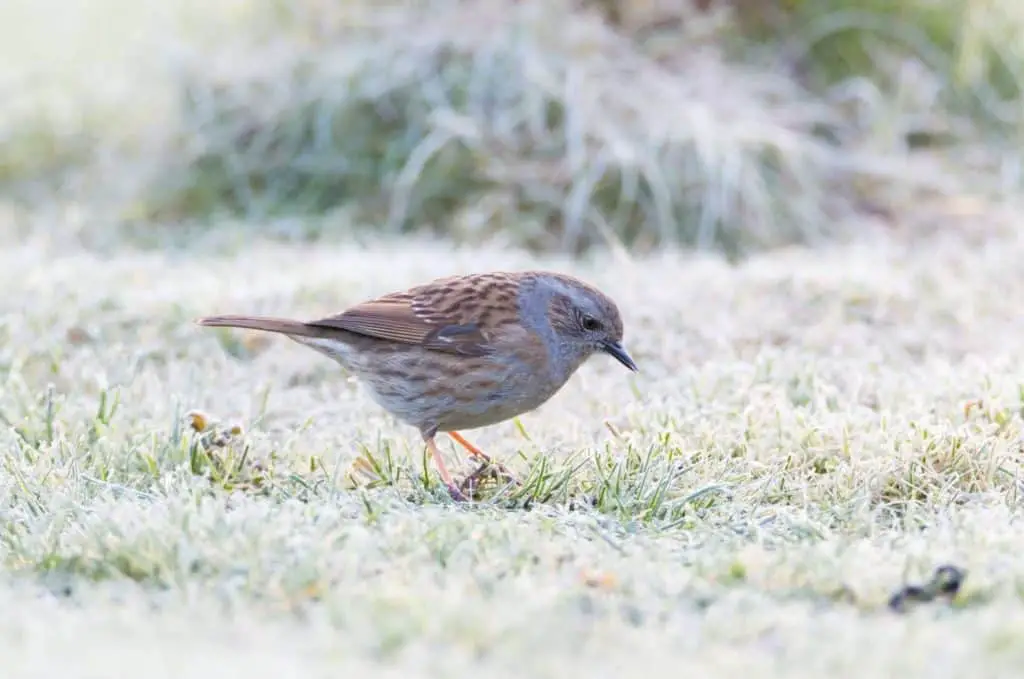You may be used to seeing dunnocks hopping about in shrubbery in your garden or on your lawn, and you may have noticed that they aren’t keen on eating from hanging bird feeders.
So, what do dunnocks eat, and how can you tempt them with some food at a bird feeding station in the winter months?
Dunnocks are omnivores, meaning that they eat both plants and animals. They mainly feed on a diet of invertebrates, commonly spiders, worms, snails and insects. In the winter, however, they will also eat seeds. They typically feed on the ground, plucking spiders, grubs and worms out of grass or soil. They can also catch insects in their beak as they fly around or perch on branches. They have been known to eat larger animals too, even mice or other small birds!
Dunnocks (or prunella modularis) are a common garden bird found in parks and woodland across the UK. They are similar in appearance to sparrows, and similar in size to robins. They belong to the bird family called ‘accentors’, and are also commonly known as hedge sparrows or hedge accentors.
Dunnocks are small birds, being only 14cm in length and with a wingspan of up to 21cm. They are recognisable by their blue-grey head colour and sharp beaks. They are timid birds, and tend to shy away from any interaction with humans.

Dunnocks are often also recognisable by their behaviour. They like to stay close to the ground when foraging for food, as their main sources of food are invertebrates. They can be found darting around in the grass or soil of your garden, scavenging for bits of food or nesting materials.
Dunnocks are unlikely to be spotted feeding from hanging feeders or a bird feeding station in your garden. Due to their diet of invertebrates, they are used to feeding on the ground. They tend to respond better to a ground bird feeder or food scattered around on the ground. They aren’t likely to want feeding in the summer months, when food is easier to come by, but may benefit from garden feeding in the winter months.
It’s important that birds such as dunnocks are given the right type of food, if fed in a garden. This is because filling up on too much of one type of food, for example bread, can mean they don’t get all the nutrients they need. This is especially important for cold winter nights, when dunnocks need all the energy they can get.
Dunnocks have been known to enjoy chopped peanuts and sunflower heart chips, along with other mixed seeds that are high in nutrients. Their sharp beaks are ideal for feeding on worms and spiders, but are not so useful for cracking open seeds. This means that whatever you feed dunnocks at a bird feeding station, it needs to be in small pieces. Dunnocks also enjoy food such as mealworms, high energy seed mix or fat balls.
Due to the fact that dunnocks are ground feeders, they are generally unresponsive to hanging feeders, even in the winter. They are most commonly found scavenging and foraging on the ground, and so this is the best place to scatter food for dunnocks. Dunnocks will eat food either scattered on your lawn or patio, or in a ground bird feeder. Ground feeding trays are readily available from wildlife stores such as Simon King Wildlife, or you can have a go at making your own!
Dunnocks and other ground-feeders will feed from disused wooden or ceramic trays. You may have something suitable lying around your house, or possibly at your local charity shop. Failing that, the garden centre will have something you can use!
- Owls: Owls are a solitary, nocturnal bird of prey, of which there are five species residing in the UK. Owls are known for their broad head, binocular vision, and sharp talons, which makethem deadly hunters. In addition to preying on small birds like dunnocks, owls also eat small mammals and insects. They hunt during the night, when they are awake, and so dunnocks sleeping in plain sight are most vulnerable.
- Hawks: Hawks are also found in the UK, and are deadly birds of prey for dunnocks, especially sparrowhawks (also known as kestrels). In addition to feeding on small garden birds, hawksprey on lizards, fish, mice, rabbits, squirrels, any other type of small game that can be found on the ground below.
- Cats: Both domestic and feral cats in the UK eat small birds such as dunnocks. Since the dunnock population is in decline, it might be best to keep your cat indoors or away from your bird feeding station, especially if there’s a nest of young dunnocks in your garden!
- Crows: There are eight species of crow present in the UK, some of which will prey on small birds such as dunnocks. Crows such as the black raven are omnivorous just like dunnocks, meaning they eat both plants and other animals.
- Seagulls: Seagulls are known in the UK for eating just about anything they can find, and small birds like dunnocks are no exception to this rule. The UK is home to six species of gull, most of which have been known to scavenge small birds, dead or alive.
So, there you have it! Dunnocks don’t often eat from hanging bird feeders in your garden, but they can be tempted by ground feeding platforms with some tasty-looking mealworms or seeds!

